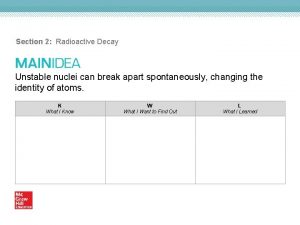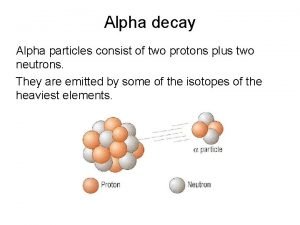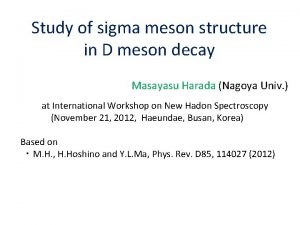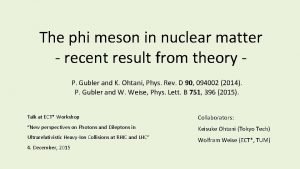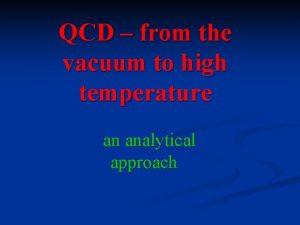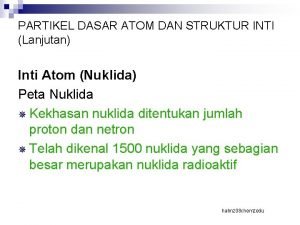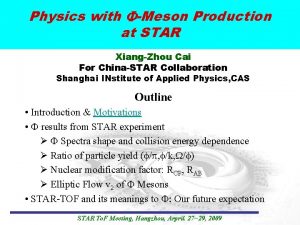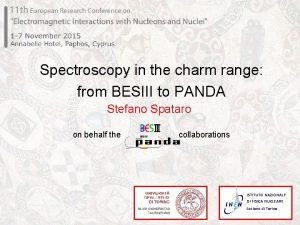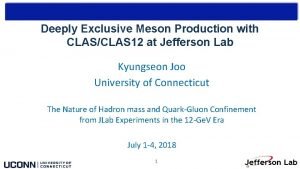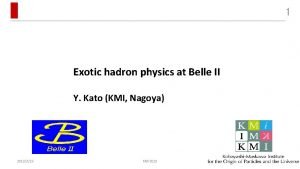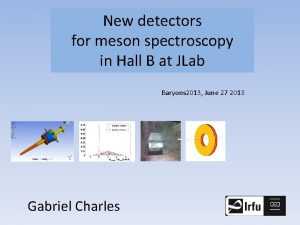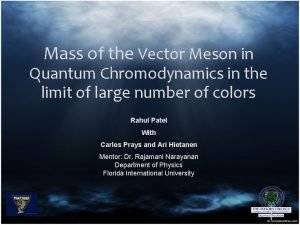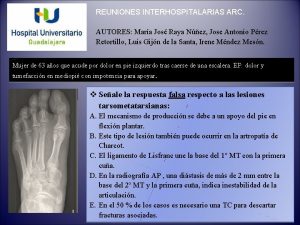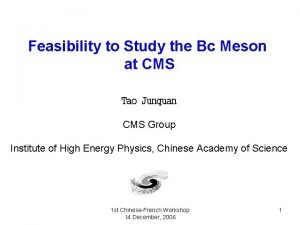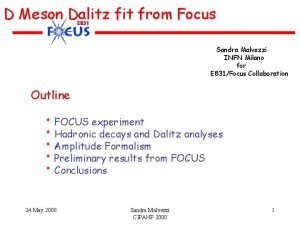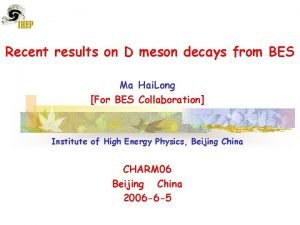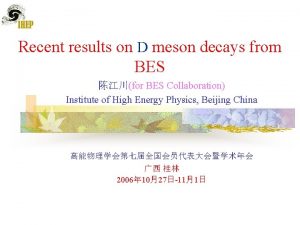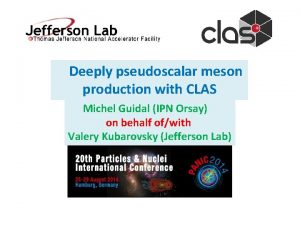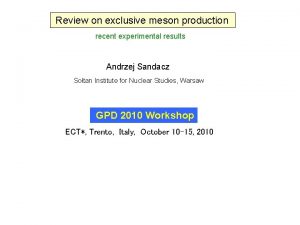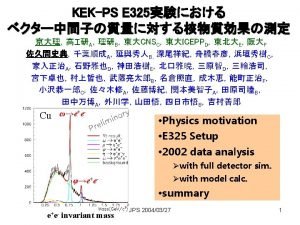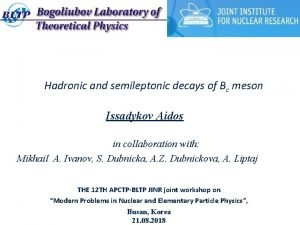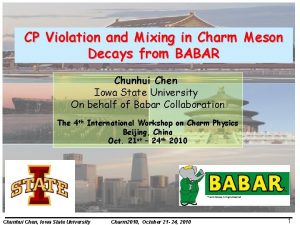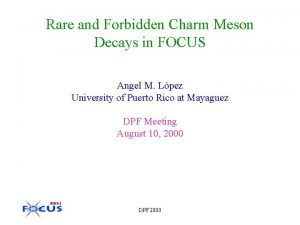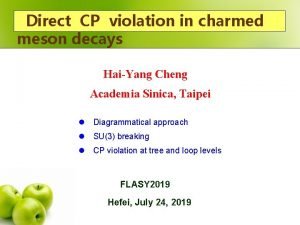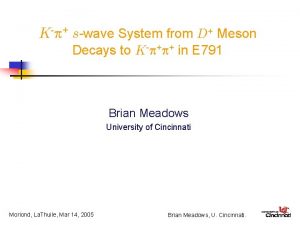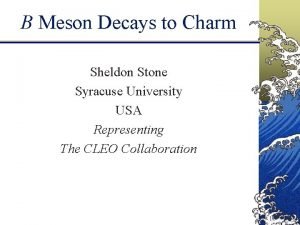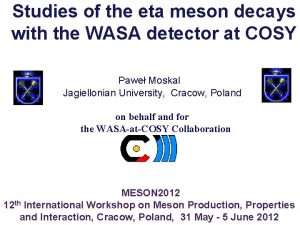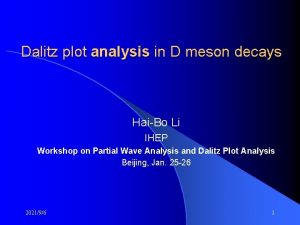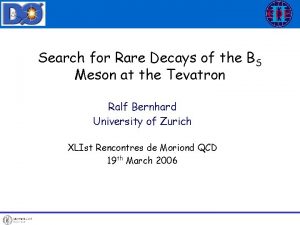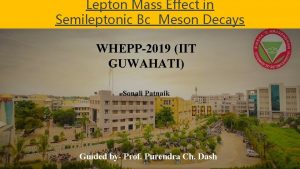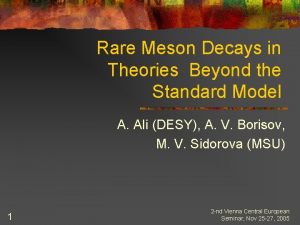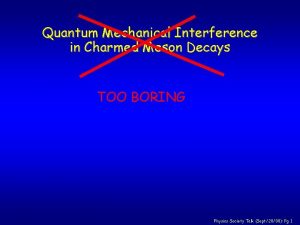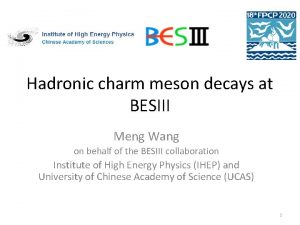Recent results and D meson production and decays





























- Slides: 29

Recent results and D meson production and decays Medina Ablikim BES Collaboration IHEP, Beijing Topical Seminar on Frontier of Particle Physics 2005 Heavy Flavor Physics 13 -17 August, Beijing 1

Outline v Semileptonic decays of D mesons v Leptonic decay of D+ meson v DD-bar Cross Section at 3. 773 Ge. V v Evidence for v Summary 2

I. Semileptonic D Decays Phys. Lett. B 597(2004)39 Phys. Lett. B 608(2005)24 Motivation § Absolute measurements § Form factors & § CKM matrix elements & § Isospin conservation implies: From PDG 04 Br 3

Method data @ around 3. 773 Ge. V Double-tagged method K Near DDbar production threshold region e+ K π π e- e 4

Singly tagged D samples Singly tagged modes , , , PID made by combining TOF & d. E/dx information : CL prob ( > 0. 1% ; K : CL , i ) > 0. 1 %, > CL i = 1, 2, 3 5

Invariant mass distribution for tags 6

Doubly tagged D decays , ; PID : Missing energy and momentum 7

8

Monte Carlo simulation n n Detection efficiency Background subtraction Mode 9

Results Ø Branching fractions (%) Experiment BES MARK III PDG 04 10

Ø Form factors Different theoretical predictions QCDSR Phys. Rev. D 66, 114002, 2000 Nucl. Phys. Prog. Suppl. 83, 28 6, 2000 LQCD(1) LQCD(2) Nucl. Phys. B 619, 565, 2001 BES CLEO Theoretical predictions are in the range from 0. 7 to 1. 4. See J. D. Richman et al. , Rev. Mod. Phys. , Vol. 67, No 4, 1995 11

Ø CKM matrix elements BES(QCDSR ) BES(LQCD(1)) BES(LQCD(2)) Input BES MARK III 12

Ø Ratio of partial widths BES MARK III PDG 04 Obtained based on the branching fractions quoted from PDG 04 BES result favors that the isospin conservation holds in D meson semi-leptonic decays 13

II. Leptonic D+ Decay Phys. Lett. B 610(2005)183 Motivation The effect of strong interaction can be parameterized by Lattice gauge, potential models bag model, QCD sum rule …, calculation predict the value of The f. D measurement will allow comparison with theoretical calculation to improve theory Mixing experiment Lattice predicts f. B/f. D with small errors. Precision measurement of f. D precision estimate of f. B 14

Method Single tags Double-tagged method e+ KDtag D+ D D- π+ π+ e- Require one additional charged track and no additional photons Neutrino carries energy and momentum away Should be around zero data @ around 3. 773 Ge. V 15

Candidate evens 3 events in the signal region Monte Carlo simulation 16

Background Ø method 1 Ø method 2 1 hadronic track in the recoil of the tags MC sample 27 times larger than data Nb = 0. 33+/-0. 11 13 events in the D-mass region Results Nb=0. 31+/- 0. 09 17

III. DD-bar Cross Section at 3. 773 Ge. V Motivation Phys. Lett. B 603(2004)130 Ø (3770) production cross section at peak based on (3770) resonance parameters: Ø DD-bar cross section MARK-III measured the observed DDbar cross section (at Ecm = 3. 768 Ge. V) production cross section Ø discrepancy & 18

Method Single-tagged method Near DDbar production threshold region Dtag e+ D+ D D- K- π+ π+ e- data @ 3. 773 Ge. V 19

From Monte Carlo PDG 20

Radiative correction Assuming that (3770) decay exlusively into PR D 62 (2000)012002 -1 sampling function (Kuraev and Fadin) Using (3770) resonance parameters quoted from PDG 2002 Radiative correction factor: 21

Tree level cross section 22

IV. Evidence for Phys. Lett. B 605(2005)63 Motivation Ø discrepancy & about 40% of psi(3770) does not decay to DD-bar ? Ø theoretical prediction 23

Selection of candidate data @ around 3. 773 Ge. V 4 good charged tacks per event is identified by combining d. E/dx, TOF, BSC & Muon Search for in two different ways 24

Ø Recoil mass of data MC Fitting to the mass distribution with three Gaussian functions plus a first order Polynomial gives, events mainly bg from 25

Open histogram is for e+e- channel, Ø Kinematic fit The events of histogram in yellow is for mu+mu- channel were fitted to the hypothesis of (mainly) requiring Fitting to the mass distribution with three Gaussian functions plus a first order polynomial gives, The histogram is psi(3686), while error bar is the psi(3686)+psi(3770) Monte Carlo The events passed K. F. bg from 26


V. Summary u. Measured the form factors & ratio of partial widths u. Observed 3 D+ leptonic decay events, and obtained u. BES measured the DD-bar Cross Section at 3. 773 Ge. V to be u. BES observed hadronic transition of in first time and measured the partial width to be 28

Thank You! 29
 A friend emails you the results of a recent high school
A friend emails you the results of a recent high school Apa itu pre production
Apa itu pre production Nuclear decays and reactions section 2
Nuclear decays and reactions section 2 Alpha decay equation uranium 238
Alpha decay equation uranium 238 Sigma meson
Sigma meson Phi meson
Phi meson Meson valves
Meson valves Partikel meson
Partikel meson Lucas 10 18
Lucas 10 18 K star meson
K star meson B meson decay
B meson decay Meson alue
Meson alue B meson decay
B meson decay Meson
Meson Meson
Meson Irene mendez meson
Irene mendez meson Mumu+
Mumu+ Meson la fit
Meson la fit Recent trends in ic engine
Recent trends in ic engine Recent developments in ict
Recent developments in ict Recent developments in object detection
Recent developments in object detection Ap synthesis prompt
Ap synthesis prompt Explain recent trends in foreign trade of india
Explain recent trends in foreign trade of india Skimming and scanning examples
Skimming and scanning examples Trends in project portfolio management
Trends in project portfolio management Recent demographic changes in the uk
Recent demographic changes in the uk Myips.schoology
Myips.schoology During a recent police investigation
During a recent police investigation After a skydiving accident laurie
After a skydiving accident laurie Recent advances in ceramics
Recent advances in ceramics


